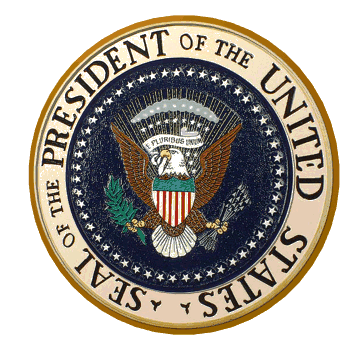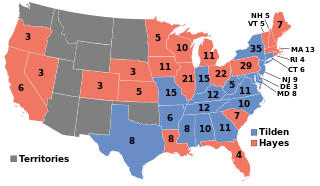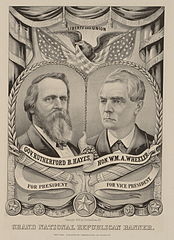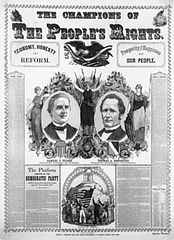 TheUSAPresidents.com
TheUSAPresidents.com 
 TheUSAPresidents.com
TheUSAPresidents.com 
 We have pages on every election!
We have pages on every election!

AndyHogan14, Public domain, via Wikimedia Commons
The 1876 election took place on Tuesday, November 7, 1876.


The Grant Administration's scandals got even worse by the time 1876 rolled around. Grant was thinking about going for a third term; he ultimately, though, went against it. Rutherford Hayes, the Republican candidate, was popular for being another Civil War hero and was even wounded in combat, making him a perfect successor to Grant. However, because Samuel Tilden was a strong Democrat and because of the Grant Administration's various scandals, the Democrats posed a true threat to the Republicans. For reasons mentioned later in this page, this would be the last election of the Reconstrucction era of the United States.
The electoral college increased to 369 electors; 185 needed to win. 8,418,659 people voted in this election. This would be the second out of five elections in which the winner did not win the popular vote.
Originally, it looked like Tilden would win. He led the popular vote and electoral vote; Republicans disputed it however. Florida, Louisiana, Oregon and South Carolina (20 electoral votes) were disputed. There had been chaos in the states; in one of them, 150 black Republicans were killed. A Constitutional crisis began as hatred and dispute swept the country. Angry people surrounded Rutherford Hayes' home, but Hayes said it was too soon for the results to be finalized. President Grant, though quietly, armed Washington D.C. with extra protection as the crisis unfolded. The Democratic House and Republican Senate on January 15, 1877, decided to create an electoral commission of fifteen people: five Representatives, five Senators, and five Supreme Court Justices. The majority party in each chamber chose three people, while the minority chose two. Because of this, there happened to be five Republicans and five Democrats. Of the Supreme Court there were two Republicans and two Democrats. The fifth justice was a man named David Davis who was an Independent. However, Democrats tried to win him over by electing him to the Senate. However, it severely backfired. Davis excused himself from the commission, and since the rest of the Justices were Republicans, Republican Joseph Bradley took his spot. His vote broke the tie, and with the commission adjourning on March 2, it announced that it had awarded all disputed votes to Hayes with a final vote of 8-7. Hayes was inaugurated privately, with a public inauguration "without disturbance", taking place on March 5. However, Democrats likely agreed to it because of an unofficial compromise referred to as the Compromise of 1877, which officially ended Reconstruction by withdrawing the last federal soldiers from South Carolina and Louisiana. This election is one of the most studied elections in American history; It is still brought up in today's politics, most recently when Senator Ted Cruz in 2021 during the 2020 election certification suggested an electoral commission just like 1876 be created to decide the election, though the motion failed.
Currier & Ives., Public domain, via Wikimedia Commons
No attribution available, from Wikimedia Commons
TheUSAPresidents.com
About Us Legal Political policy Reliability
Information on this site should not be plagiarized. This site is intended for hobby purposes, not commercial. Visit here for more information.